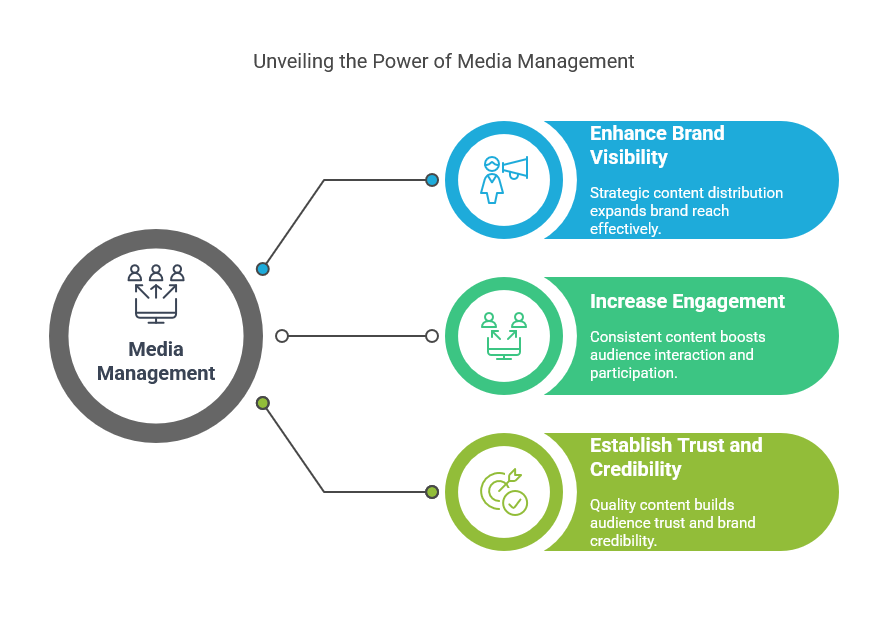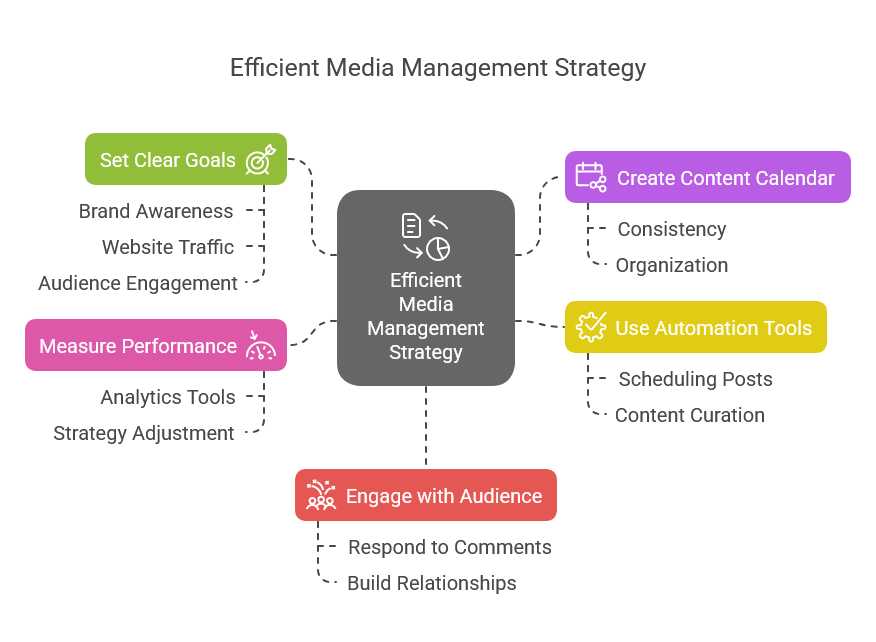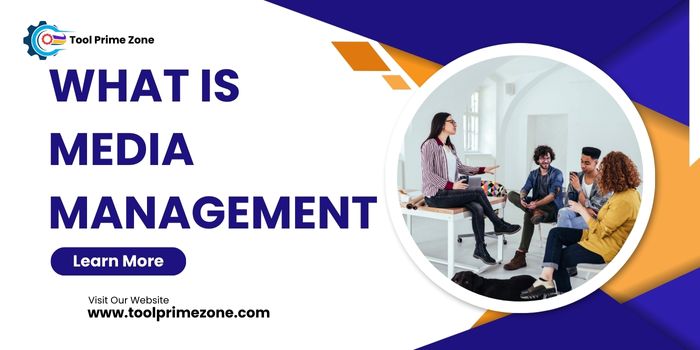In today’s digital world, the way you manage your media can have a significant impact on the success of your brand. Media management refers to the process of organising, storing, distributing, and analysing media content across various platforms, including social media, websites, blogs, and digital marketing channels.
Efficient media management ensures that your content is delivered to the right audience at the right time. It’s about more than just sharing pictures or videos; it’s about strategic planning and understanding your audience’s needs to create content that drives engagement, builds your brand, and increases conversion rates.
A report from the Content Marketing Institute shows that 70% of marketers plan to focus on creating more personalised content in the future. Personalisation helps improve the effectiveness of your media strategy.
Why Media Management Matters for Your Brand
Media management is essential for every business, big or small. It helps maintain consistency across different platforms while ensuring your brand’s message resonates with your audience. Proper media management can:
-
Enhance your brand’s visibility: By organising and distributing content strategically, your brand is more likely to reach a wider audience.
-
Increase engagement: Consistent and relevant content that’s shared on the right platforms encourages engagement.
-
Establish trust and credibility: Delivering quality content consistently builds trust among your audience, helping you establish a strong, credible presence.
A solid media management strategy allows your business to maintain control over its digital footprint. By utilising tools and techniques to track and measure success, you can make informed decisions and ensure you’re constantly improving your media strategy.
Quote: “Content is king, but distribution is queen, and she wears the pants.” – Jonathan Perelman, VP of Digital Initiatives at IAC

Key Components of Media Management
Media management involves several components that, when effectively combined, contribute to a cohesive strategy. These components include:
-
Content Creation: Content is the foundation of media management. Whether it’s articles, blog posts, images, videos, or infographics, creating high-quality content that aligns with your brand values and audience interests is key.
-
Content Curation: Not all content needs to be created from scratch. Curating relevant content from external sources allows you to provide additional value to your audience without always having to generate original material.
-
Distribution: Distributing your content effectively across different platforms ensures it reaches your target audience. Whether through email marketing, social media channels, or your website, distribution channels play a huge role in the effectiveness of your media strategy.
-
Analytics and Reporting: To optimise your media management efforts, tracking performance is vital. Media management tools offer valuable insights into content performance, engagement levels, and audience preferences, enabling you to refine your strategy over time.
The Role of Technology in Media Management
In the past, media management was a manual, time-consuming task. However, with the rise of digital technology, businesses now have access to tools and platforms that make media management more efficient and effective.
Technology has transformed how content is created, managed, and analysed. Platforms like social media schedulers, media asset management systems, and data analytics tools enable businesses to streamline operations, minimise human error, and make informed, data-driven decisions.
Tools like Hootsuite, Buffer, and Sprout Social can automate social media posting, content scheduling, and monitoring engagement. Google Analytics and HubSpot help track your content’s performance and provide insights into what’s working and what’s not.
Quote: “Technology allows us to manage content like never before. It’s not just about creating, it’s about optimizing the entire process.” – Mark Zuckerberg, CEO of Facebook.
Best Practices for Efficient Media Management
An effective media management strategy requires a clear plan and proper execution. Here are some best practices to follow:
-
Set clear goals: Before creating content, it’s essential to know the objectives of your media strategy. Whether it’s brand awareness, increasing website traffic, or engaging with your audience, your content should align with these goals.
-
Create a content calendar: Planning ahead ensures a steady stream of content to post across platforms. A content calendar helps you stay organised and maintain consistency.
-
Use automation tools: Automating tasks such as scheduling posts or curating content allows you to save time and focus on other aspects of media management.
-
Measure performance: Analytics tools help you understand which content resonates with your audience, allowing you to adjust your strategy accordingly.
-
Engage with your audience: Don’t just post content and leave it. Respond to comments, messages, and mentions to build relationships with your followers.

Media Management Tools You Need to Know About
Several tools can help you streamline your media management strategy. These tools make it easier to manage multiple platforms, schedule posts, analyse performance, and more.
-
Hootsuite: A popular social media management tool that allows users to schedule posts, monitor conversations, and track engagement across multiple platforms.
-
Buffer: Buffer helps you schedule posts for social media platforms like Facebook, Twitter, LinkedIn, and Instagram. It also provides analytics to track the performance of your content.
-
Canva: A graphic design tool that helps you create professional-looking images, infographics, and videos for your media channels.
-
Google Analytics: An essential tool for tracking website performance. It helps you measure traffic, user behaviour, and conversions, providing insights to improve your media strategy.
-
Trello/Asana: Project management tools that can help you organise and collaborate with your team on media creation, scheduling, and analytics tracking.
Overcoming Challenges in Media Management
While media management is essential, it’s not without its challenges. Some of the common obstacles businesses face include:
-
Content Overload: With numerous media types and platforms available, it can be challenging to keep up with the constant demand for new content.
-
Platform Diversity: Managing content across various platforms, such as Instagram, Facebook, Twitter, and YouTube, can be time-consuming and confusing. Each platform has its own rules, audience, and content formats.
-
Staying on Brand: With so much content being created and shared, maintaining consistency in your brand voice and messaging can be challenging.
-
Measuring ROI: It’s often hard to determine the direct impact of media content on your business goals, making it difficult to justify the return on investment (ROI) for media spending.
Statistic: According to HubSpot, 61% of marketers say generating traffic and leads is their top challenge. Efficient media management can resolve this by ensuring content reaches the right audience and encourages engagement.
The Importance of Content Analytics in Media Management
Analytics is an essential component of any successful media management strategy. Tracking the performance of your content allows you to make data-driven decisions, optimise your strategy, and improve engagement.
Analytics tools like Google Analytics, Sprout Social, and Socialbakers provide valuable insights into which content performs best, what times to post, and which platforms yield the best results. By measuring your content’s performance, you can enhance your media management efforts and more effectively meet your audience’s needs.
Future Trends in Media Management
Media management is constantly evolving, especially with the rapid rise of new technologies. In the future, media management will be increasingly powered by artificial intelligence (AI) and machine learning. AI will help automate tasks such as content creation, posting, and even audience engagement.
As AI continues to grow, businesses will be able to create hyper-personalised content that speaks directly to their audience. Additionally, AI-driven analytics tools will provide deeper insights into user behaviour, allowing businesses to refine their strategies in real-time.
FAQ
-
What is media management? Media management is the process of creating, organising, distributing, and analysing media content to ensure it reaches the right audience on the right platforms.
-
Why is media management important for businesses? It helps businesses maintain brand consistency, increase visibility, and drive engagement with their audience.
-
What tools are used for media management? Popular tools include Hootsuite, Buffer, Canva, Google Analytics, and Trello or Asana for content management, scheduling, and analysis.
-
How can I improve my media management skills? Set clear goals, use media management tools, plan content in advance, and track performance regularly to refine your strategy.
-
What are the challenges in media management? Common challenges include content overload, managing multiple platforms, maintaining brand consistency, and measuring return on investment (ROI).
Effective media management is the backbone of a successful digital marketing strategy. By using the right tools, understanding your audience, and measuring your success, you can ensure your media content reaches the right people and drives business growth. Stay on top of the latest trends, use analytics to improve, and streamline your media management practices to keep your brand ahead of the competition.

